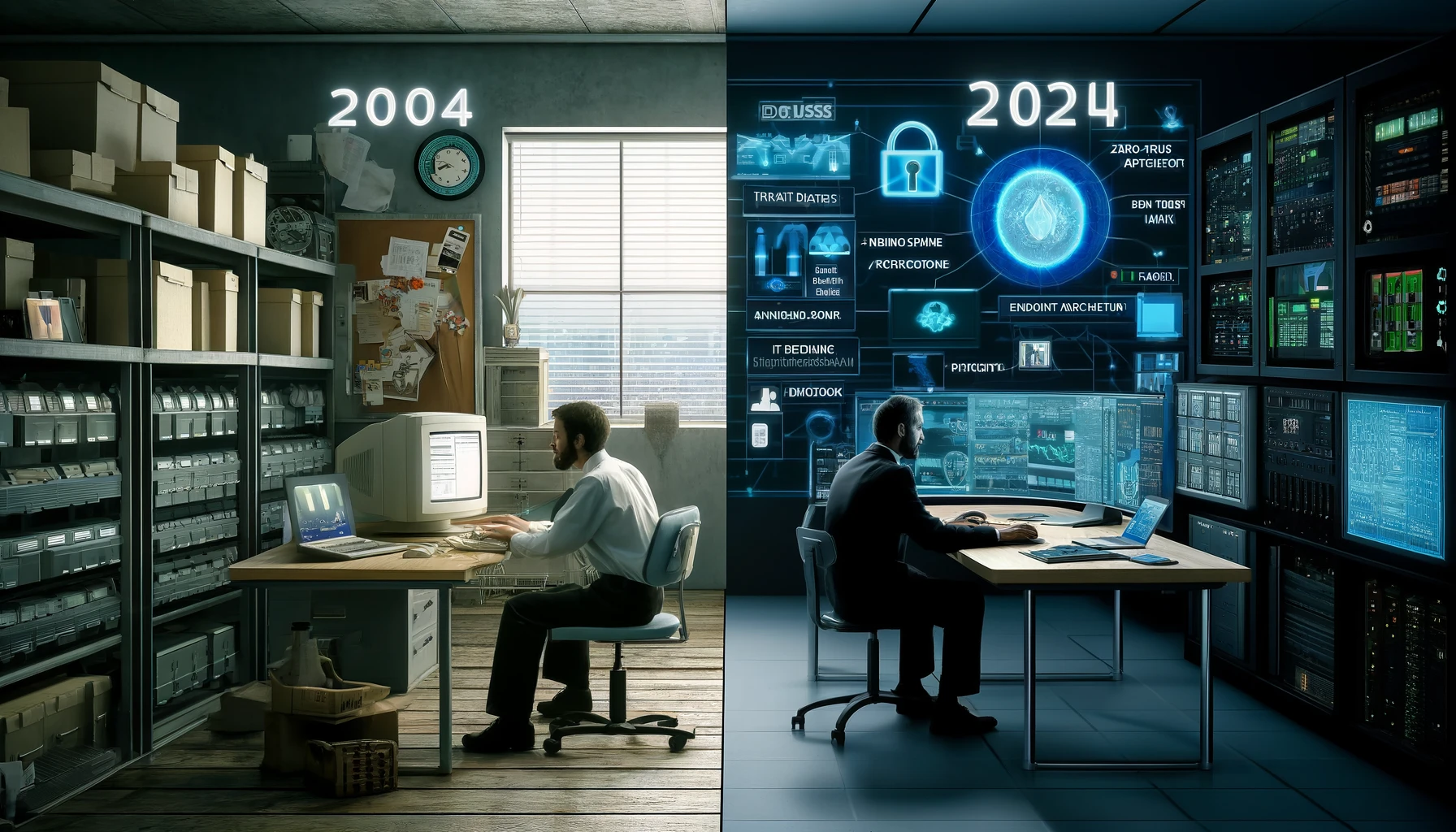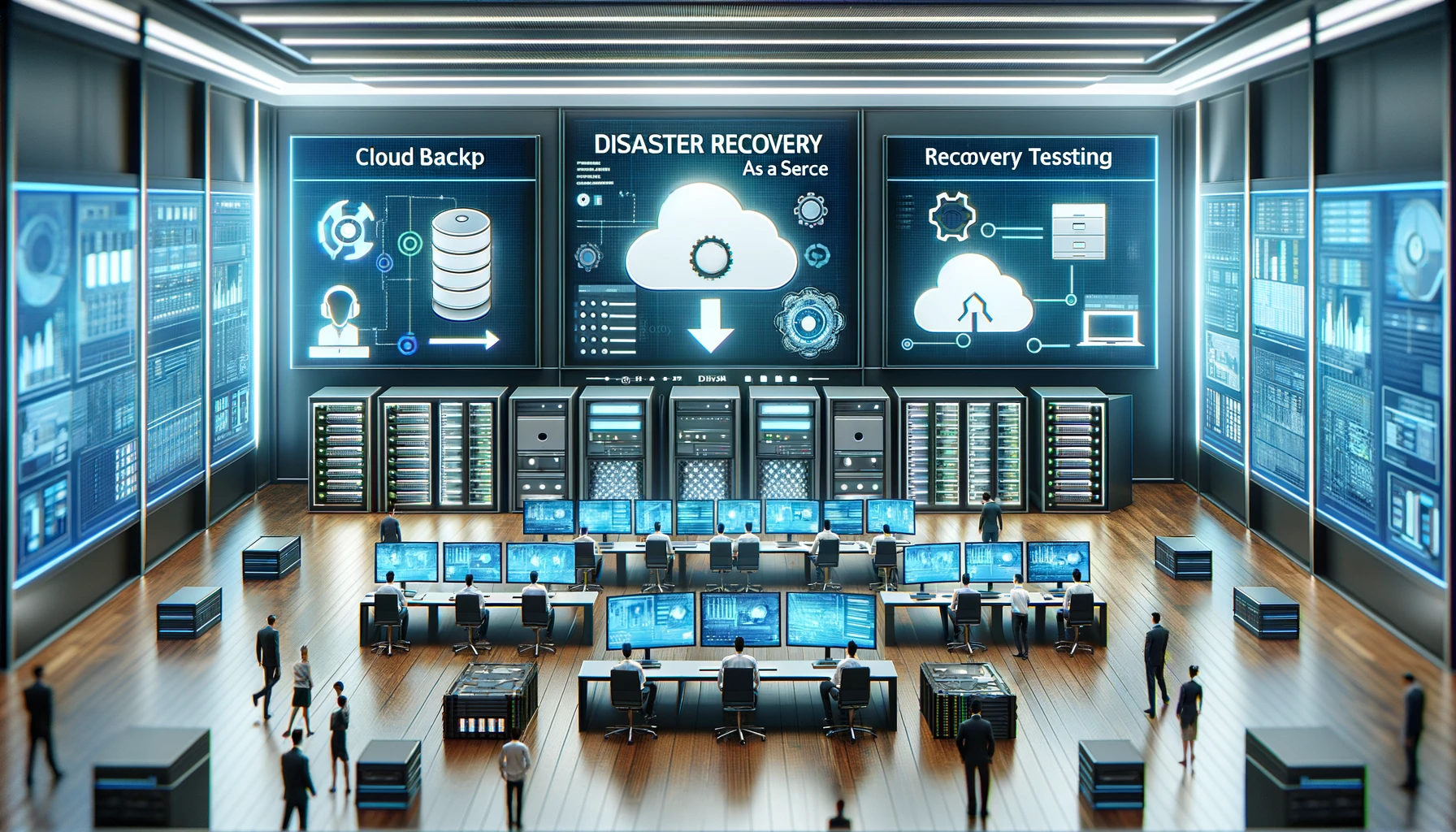The Evolution of IT: 2 decades¶
 The landscape of information technology has undergone tremendous transformation over the past two decades. In 2004, IT was primarily seen as a support function, essential for maintaining business operations but often isolated from the strategic core of the organization. Fast forward to 2024, IT has become a critical driver of business innovation and competitive advantage. This evolution is particularly evident when examining the changes in IT operations and IT governance.
The landscape of information technology has undergone tremendous transformation over the past two decades. In 2004, IT was primarily seen as a support function, essential for maintaining business operations but often isolated from the strategic core of the organization. Fast forward to 2024, IT has become a critical driver of business innovation and competitive advantage. This evolution is particularly evident when examining the changes in IT operations and IT governance.
IT Operations: From Reactive Maintenance to Proactive Innovation¶
Infrastructure¶
2004: Physical Servers and Data Centers In 2004, IT infrastructure was dominated by physical servers and on-premise data centers. Organizations invested heavily in maintaining and upgrading hardware, which required significant space, energy, and cooling resources. The process of scaling up involved purchasing new hardware, which was both time-consuming and costly.
2024: Cloud-Based and Hybrid Environments By 2024, the landscape has shifted dramatically towards cloud-based infrastructure. Companies now leverage public, private, and hybrid cloud environments to achieve scalability, flexibility, and cost-efficiency. Cloud service providers like Microsoft Azure offer robust infrastructure as a service (IaaS) and platform as a service (PaaS) solutions that enable organizations to scale resources up or down based on demand. This shift has also facilitated global operations and remote work, enabling businesses to deploy applications and services closer to their users.
Software Development¶
2004: Manual Installations In 2004, software deployment was largely a manual process. IT teams installed and updated software on individual machines, a time-consuming task prone to human error. Application updates often led to downtime, affecting business operations.
2024: Continuous Integration/Continuous Deployment (CI/CD) Today, CI/CD pipelines have revolutionized software deployment. With tools like Jenkins and Azure DevOps, organizations automate the building, testing, and deployment of applications. This automation reduces errors, accelerates release cycles, and ensures that new features and updates are delivered seamlessly. Containerization technologies like Docker and orchestration tools like Kubernetes further enhance deployment efficiency by ensuring applications run consistently across different environments.
Monitoring¶
2004: Basic Monitoring In 2004, IT monitoring was reactive and rudimentary. Tools, like Cynon, were limited to basic network and server monitoring, alerting IT staff to issues after they occurred. Troubleshooting and resolving these issues often required manual intervention, leading to prolonged downtime.
2024: AI-Driven Monitoring and Analytics Modern IT operations leverage advanced monitoring solutions powered by artificial intelligence (AI) and machine learning (ML). Tools like Splunk, Datadog, and New Relic provide real-time insights into application performance, infrastructure health, and user experience. Predictive analytics detect potential issues before they impact operations, allowing for proactive remediation. Automated incident response systems can resolve common problems without human intervention, ensuring minimal disruption to business continuity.
Automation¶
2004: Limited Automation Automation in 2004 was limited to simple scripts and batch files. While these could handle repetitive tasks, most IT operations were manual, increasing the risk of errors and inefficiencies.
2024: Extensive Automation The rise of sophisticated automation tools has transformed IT operations. Solutions like Ansible, Puppet, and Chef automate configuration management, while robotic process automation (RPA) tools streamline business processes. This extensive automation not only enhances operational efficiency but also allows IT teams to focus on strategic initiatives and innovation.
Security¶
 2004: Basic Security Measures
In 2004, IT security was relatively basic, relying on firewalls, antivirus software, and manual patch management. Security was often an afterthought, with many organizations only implementing measures in response to incidents.
2004: Basic Security Measures
In 2004, IT security was relatively basic, relying on firewalls, antivirus software, and manual patch management. Security was often an afterthought, with many organizations only implementing measures in response to incidents.
2024: Comprehensive Cybersecurity Strategies The cybersecurity landscape in 2024 is vastly more complex and critical. Organizations adopt a zero-trust architecture, ensuring that every access request is thoroughly verified. Advanced threat detection and response (XDR) solutions provide holistic visibility and defense against sophisticated attacks. Endpoint protection has evolved to include next-generation antivirus, endpoint detection and response (EDR), and mobile threat defense (MTD). The cybersecurity mesh architecture (CSMA) integrates multiple security tools into a cooperative ecosystem, enhancing overall security posture.
Backup and Recovery¶
2004: Basic Backup Solutions Backup and recovery solutions in 2004 relied on tape drives and basic offsite storage. Disaster recovery plans were often rudimentary, with limited testing and verification.
2024: Advanced DRaaS Modern backup and recovery solutions leverage cloud technology to provide robust, scalable, and automated backups. Disaster recovery as a service (DRaaS) ensures that organizations can quickly recover from disruptions with minimal data loss. Regular testing and validation of recovery plans ensure readiness for any eventuality.
IT Governance: From Compliance to Strategic Alignment¶
Frameworks¶
2004: Early Frameworks In 2004, IT governance frameworks were in their infancy. COBIT 4.0 and early versions of ITIL offered foundational guidelines for aligning IT operations with business objectives and ensuring compliance with regulatory requirements such as Sarbanes-Oxley (SOX). However, these frameworks were often not deeply implemented within IT departments.
2024: Comprehensive and Integrated Frameworks By 2024, IT governance frameworks have significantly evolved to include a wider array of standards and regulations. COBIT 2019 and ITIL 4 now provide extensive guidelines for managing IT services, promoting continuous improvement, and aligning IT with business strategies. Organizations are also required to comply with numerous data privacy regulations, including GDPR, CCPA, and HIPAA, necessitating integrated compliance frameworks. Additionally, NIST CSF 2.0 offers comprehensive support for achieving robust cybersecurity measures.
Focus¶
2004: Compliance and Alignment The primary focus of IT governance in 2004 was ensuring compliance with regulatory requirements and aligning IT operations with business goals. IT governance was often seen as a separate function from core business operations.
2024: Business Value and Agility In 2024, IT governance is integral to business strategy, focusing on delivering business value and enhancing agility. Governance frameworks support digital transformation initiatives, ensuring that IT investments drive innovation and competitive advantage. This strategic alignment is critical for organizations to respond to rapidly changing market conditions and technological advancements.
Risk Management¶
2004: Basic Risk Assessments Risk management practices in 2004 were primarily focused on financial and operational risks. Basic risk assessments were conducted periodically, with limited emphasis on cybersecurity and data privacy risks.
2024: Comprehensive Enterprise Risk Management (ERM) Modern risk management encompasses a broader range of risks, including cyber risks, data privacy, and third-party risks. Enterprise risk management (ERM) frameworks provide a holistic approach to identifying, assessing, and mitigating risks. Advanced analytics and AI-driven tools enable continuous risk monitoring and proactive mitigation strategies.
Policies¶
2004: Static Policies IT policies in 2004 were typically static documents, reviewed annually or bi-annually. These policies often lagged behind technological advancements and emerging threats.
2024: Dynamic and Responsive Policies In 2024, IT policies are dynamic and continuously updated to address emerging threats and business changes. Automated policy management tools ensure that policies remain current and effective. Organizations adopt a risk-based approach to policy development, ensuring that security measures are proportionate to the level of risk.
Stakeholder Engagement¶
2004: Limited Engagement Stakeholder engagement in IT governance was limited to IT and executive management, with sporadic involvement of other business units. This often led to a disconnect between IT initiatives and business needs.
2024: Extensive Engagement By 2024, stakeholder engagement in IT governance has expanded to include all business units. Regular feedback loops and collaborative governance models ensure that IT initiatives align with business objectives. Cross-functional teams work together to drive digital transformation and innovation.
Data Governance¶
2004: Basic Data Management Data governance practices in 2004 were basic, focusing on data management and quality. Organizations had limited frameworks for managing data lifecycle and ensuring data privacy.
2024: Advanced Data Governance The data explosion of the past two decades has necessitated advanced data governance frameworks. Modern data governance encompasses data privacy, data ethics, and AI governance. Organizations implement robust data management practices, ensuring data quality, security, and compliance with regulatory requirements. Advanced analytics and AI tools enable organizations to derive actionable insights from data while maintaining privacy and ethical standards.
Key Drivers of Change¶
The transformation of IT operations and IT governance over the past two decades has been driven by several key factors:
- Technology Evolution: The shift from on-premise to cloud computing, the rise of AI and machine learning, and the proliferation of IoT devices have fundamentally changed the IT landscape.
- Cybersecurity Threats: The increasing complexity and frequency of cyber threats have necessitated more robust security measures and governance practices.
- Regulatory Environment: Enhanced regulations around data privacy and security require comprehensive compliance and governance frameworks.
- Business Expectations: The need for IT to drive business innovation and agility has led to a closer alignment between IT and business strategies.
- Workforce Dynamics: The shift to remote work has driven the adoption of collaboration tools and strategies that support distributed teams.
- Data Explosion: The exponential growth in data volume has necessitated effective data management, analytics, and governance.
What to Expect in the Near Future for IT Operations and IT Governance¶
As we look towards the near future, several key trends and advancements are expected to shape IT operations and governance:
IT Operations¶
- AI and Automation Integration: The integration of artificial intelligence (AI) and machine learning (ML) will continue to enhance automation, driving efficiencies and enabling predictive maintenance and self-healing systems.
- Edge Computing: With the rise of Internet of Things (IoT) devices, edge computing will become more prevalent, bringing data processing closer to the source and reducing latency.
- 5G Adoption: The widespread adoption of 5G technology will improve network speed and reliability, supporting advanced applications such as augmented reality (AR) and virtual reality (VR).
- Enhanced Cybersecurity: Cybersecurity strategies will become more sophisticated, focusing on AI-driven threat detection, zero trust architecture, and comprehensive endpoint protection.
IT Governance¶
- Integrated Compliance: Organizations will adopt more integrated compliance frameworks to manage diverse regulatory requirements seamlessly.
- Data Privacy and Ethics: As data privacy concerns grow, IT governance will emphasize ethical data usage and robust privacy protections.
- Sustainability Initiatives: Sustainable IT practices will gain importance, with a focus on reducing energy consumption and e-waste through green IT initiatives.
- Agile Governance: Agile methodologies will be increasingly applied to IT governance, enabling faster decision-making and better alignment with dynamic business needs.
These advancements promise to further integrate IT with business strategy, driving innovation, efficiency, and resilience in the face of evolving challenges and opportunities.
From a support function to a strategic enabler¶
 The evolution of IT operations and IT governance from 2004 to 2024 shows to me that IT has transitioned from a support function to a strategic enabler of business success.
The evolution of IT operations and IT governance from 2004 to 2024 shows to me that IT has transitioned from a support function to a strategic enabler of business success.
Looking ahead, the near future promises even more transformative changes. The integration of AI and automation will further enhance operational efficiencies, while edge computing and 5G adoption will enable faster, more reliable data processing and communication. Advanced cybersecurity measures will be essential in protecting against increasingly sophisticated threats.
On the governance front, integrated compliance frameworks will become critical for managing diverse regulatory requirements seamlessly. Data privacy and ethics will take center stage, ensuring that organizations handle data responsibly and transparently. Sustainability initiatives will gain importance, with IT governance playing a key role in driving green IT practices. Agile methodologies will be increasingly applied to governance, enabling faster decision-making and better alignment with dynamic business needs.
Embracing these advancements will be essential for organizations to thrive in the digital age. By leveraging cutting-edge technologies, adopting comprehensive governance frameworks, and implementing proactive risk management strategies, businesses can drive innovation, enhance efficiency, and ensure resilience in the face of evolving challenges and opportunities. The future of IT operations and governance is bright, promising a more integrated, strategic, and forward-thinking approach to managing technology and business processes.